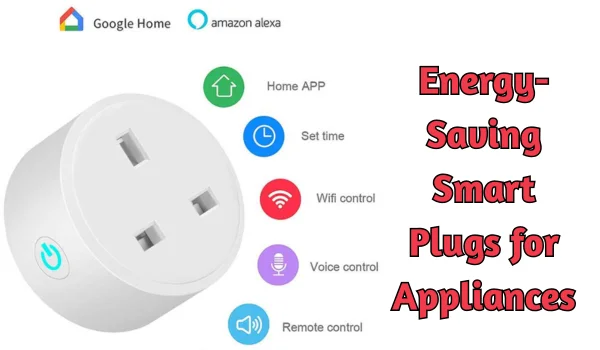Energy-Saving Smart Plugs for Appliances: A Smart Energy Expert’s Guide for India (2025 Update)
India’s electricity demand is soaring, especially with cooling needs growing at 15–20% per year, as per the India Cooling Action Plan. Much of this energy is consumed by appliances left on standby—or “vampire devices”—which British Gas estimates can inflate household bills by up to 23% annually. In this scenario, energy-saving smart plugs offer a high-impact, affordable tool to optimize appliance energy use and reduce both consumption and bills.
What Are Smart Plugs & How Do They Help?
A smart plug is a compact device that you plug into a regular wall socket; it then connects to your smartphone or voice assistant to enable remote control of appliances. Think of turning a regular fan, light, or kettle into a smart appliance—with no rewiring needed.

Energy-saving capabilities include:
- Remote on/off control, preventing needless standby power usage.
- Scheduling, which lets appliances auto-turn-off after use or when not needed.
- Energy monitoring, notifying you of real-time electricity usage and cost implications.
- Safety features, including overload protection and reduced fire risk.
A Reddit user summed it up practically:
“All the smart plugs … go off at midnight. This stops ghost power from being pulled on things like TVs and cable boxes.”
Market Trends: Smart Plugs in India & Globally
Globally, the smart plug market is booming. Forecasts estimate its value at USD 4.21 B by 2025, expected to reach USD 13.48 B by 2030 at a CAGR of 26.22%. Asia-Pacific, including India, is the fastest-growing region.
In India specifically, the broader smart home energy management device market (including smart plugs) reached USD 150.2 M in 2024 and is projected to hit USD 692.1 M by 2033, growing at a 17.7% CAGR.
Key Energy-Saving Features to Look for in Smart Plugs
| Feature | Benefit |
| Energy Monitoring | Understand exact energy consumption of each appliance |
| Scheduling & Automation | Turn devices off when not needed; integrate with routines |
| Power Limits / AI Control | Limit appliance power use; auto-cut off devices like water heaters. |
| Voice Assistant & App Control | Convenient home control via Alexa, Google, Siri |
| Connectivity | Wi-Fi, Bluetooth, Zigbee options—Wi-Fi dominates India. |
Matter 1.3 and AI-driven features are the emerging technologies to watch.
Real-World Energy Savings
Energy-saving potential is tangible. One user estimated savings of over USD 165/year (~₹14,000) using smart plugs at home. Even saving mere watts in standby—since 1 watt over a year equals 8.76 kWh—compounds into sizable reductions.
Why Smart Plugs Are Especially Smart in India
Scaling Cooling Demand: Smart plugs help optimize use of energy-hungry appliances like ACs and heaters.
Rising Appliance Penetration: As more households adopt smart home solutions, the need for plug-level control grows.
Smart Grid & Renewables: With India expanding its non-fossil fuel energy share significantly, distributed devices like smart plugs aid load management.
Choosing the Right Smart Plug in India
Prioritize:
- Energy monitoring capability
- Scheduling / automation features
- Safety certifications and overload protection
- Voice assistant & Matter compatibility
- Correct power rating (e.g., 5–10A for most appliances)
Brands like TP-Link Kasa, Eve Energy, Eve (HomeKit/Thread), and Amazon Smart Plug are globally trusted. TechRadar’s 2025 recommendations highlight Eve Energy (great for energy tracking), WiZ (budget-friendly), TP-Link Kasa (power strip automation), Amazon Plug (Alexa seamless), and Philips Hue Plug (lighting integration).
Best Usage Tips for Maximum Savings
- Schedule standby-heavy devices off (e.g., TVs, gaming consoles at midnight).
- Set consumption limits for high-draw appliances to auto-shut off.
- Use voice routines: “Goodnight” could turn off lamps, fans, chargers—automatically.
- Analyze usage trends to cut phantom loads from chargers or router always-on draw.
- Pair with smart strips for multiple device control when needed.
Safety & Privacy Considerations
Smart plugs are internet-connected devices, bringing potential security risks. Proper setup is key: secure Wi-Fi, up-to-date firmware, and trusted brands. Additionally, reset and avoid overloading—ensure you choose a plug matching appliance wattage.
Conclusion: A Smart Step Forward
In India’s energy-hungry landscape, energy-saving smart plugs offer one of the simplest yet highest-value energy interventions. With features like scheduling, monitoring, and intelligent automation, households can reduce energy waste, save money, and step into a smarter home ecosystem—without a full renovation. And as smart home adoption and energy reform accelerate, smart plugs are poised to touch every Indian home.
